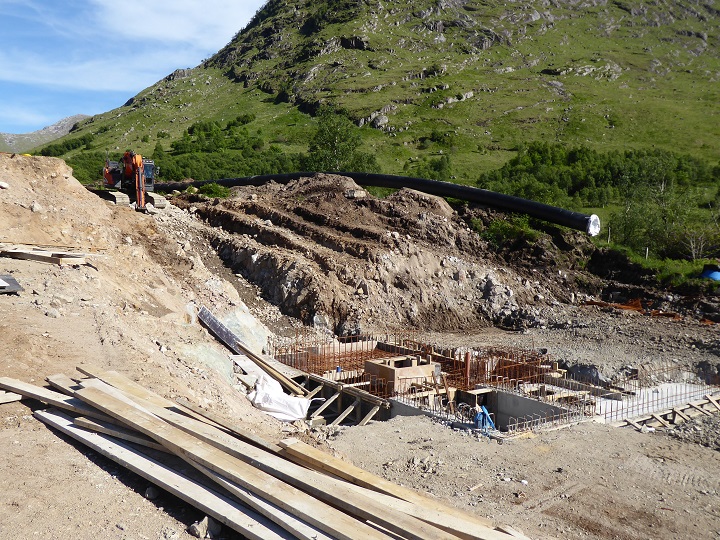
When I stumbled across an unburied hydro pipeline in the Lakes recently (see here) it got me thinking about whether it might not be far less destructive and better for the landscape and natural environment if we left hydro pipelines above the ground. I could not help comparing that scheme in the Lakes to what I had witnessed earlier in the month when I had walked down the line of the Allt Ceitlein, one of the seven hydro pipelines being constructed in Glen Etive (whose wider landscape impact I considered here).
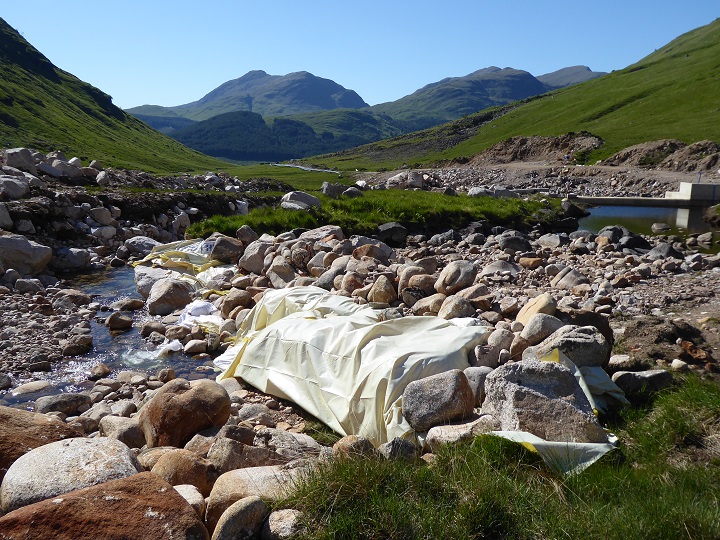
Broadly speaking most of the ground alterations visible in the foreground of this photo are attributable to the construction of the hydro intake but most of those below the intake are attributable to the burying of the pipeline. The photo helps shows extent of the impacts caused by the construction of run of river hydro intakes and why they should never have been allowed in special places such as this. The question, however, I will consider in this post is whether burying the pipeline connecting the Allt Ceitlein and intake and powerhouse may have made a bad decision even worse.
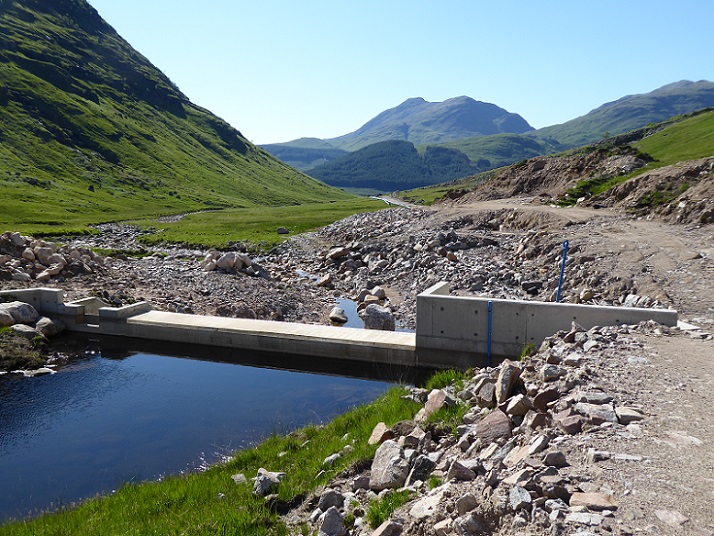
While some of the excavations below the intake were required to construct it, burying the pipeline has required further excavations and considerable movement of rock and earth. Restoring the land back from the new boulderfield that now sits above the pipe will be a considerable challenge and the way the work has been done so far will not make it any easier.
A pipe lying in the open might be ugly but would it have looked worse?

Part of the reason for the extent of the the destruction immediately below the intake is the nature of the ground. It requires heavy machinery and considerable movement of material to bury pipes under rock and boulders.
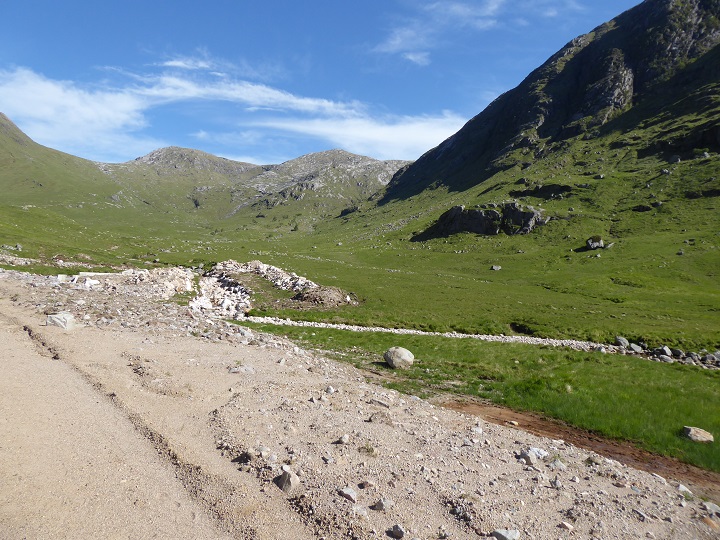
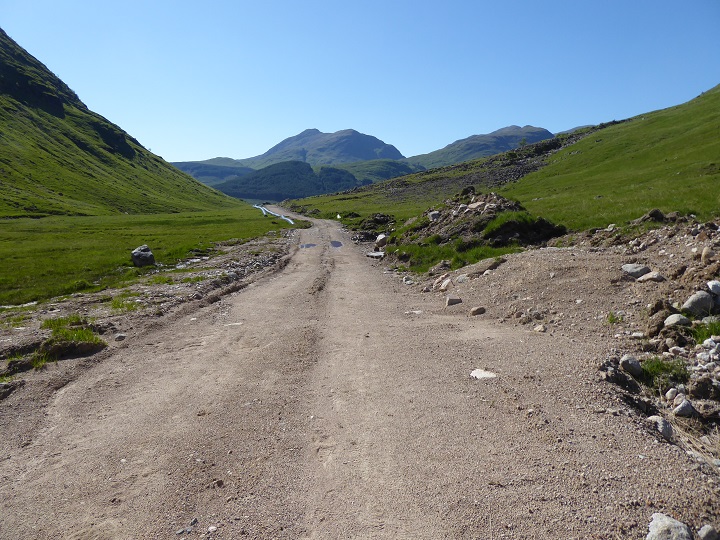
In theory, where pipes are buried in soil or peat, it should be much easier to restore the ground above to resemble the original. But generally a construction track is still required and that adds considerably to the impact. Unlike the schemes at the Allt Mheuran and Allt Chaorain, Highland Council has agreed that this construction track does not require to be removed, only narrowed. It is too early to say how this track will look but the area of disturbed ground is considerable.

The argument for burying pipes in ground such as this is that it should be possible to remove the vegetation, excavate the trench, drop in the pipeline, bury it (removing any excess material)l and then replace the turf and where that happens the line of any buried pipe should be invisible. In this case, however, the turf has not been saved but instead mixed with the excess spoil and dumped above the pipe. This should never have been allowed to happen.
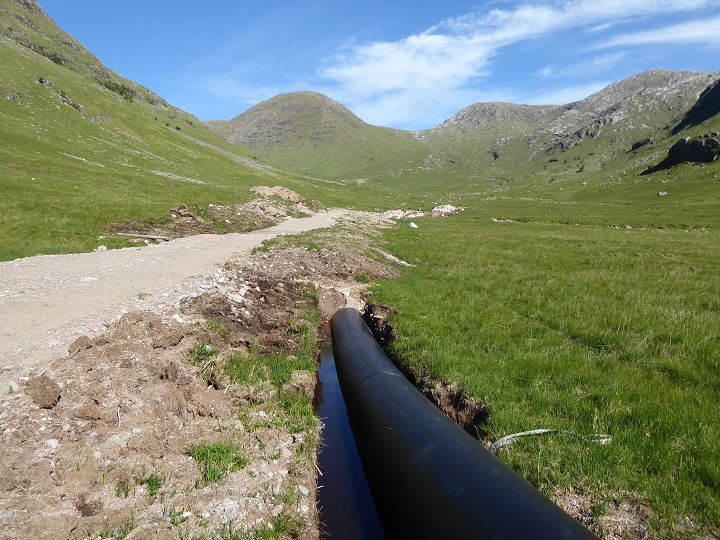
While plants should rapidly colonise the bare areas visible in the photo, the soil has been altered by mixing the peaty soil with the substrata. This changes the mineral composition of the soil and as a result the vegetation cover is likely to change: many of the dozens of buried hydro pipelines in Scotland are now marked by a swathe of soft rush.
By also failing to remove the excess material, the developer – Dickins hydro – has created a raised line across an area that was formerly flat and altered the landform.
This is not a restored landscape but a modified one. This damage should, in theory, have been avoided but that would have required properly qualified and supervised contractors and the current system does not allow for that. What is easy in theory, in practice in rarely happens. This adds to the argument for a re-think: if planning authorities are so helpless when it comes to protecting the landscape and enforcing planning conditions, would we not be better leaving the pipes in the open?
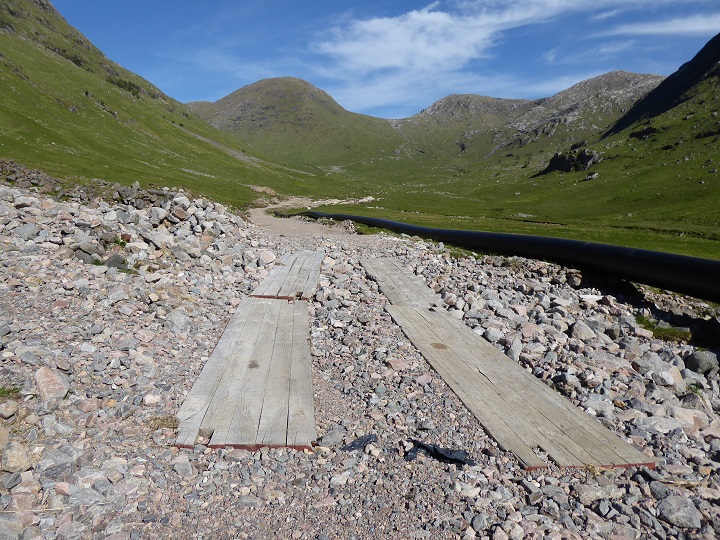
In theory too, not all rocky areas should be difficult to restore. Burying the pipe below the boulders at the bottom of this debris flow shouldn’t make much difference. But then its already been damaged and its natural form altered through the construction of the hydro track!
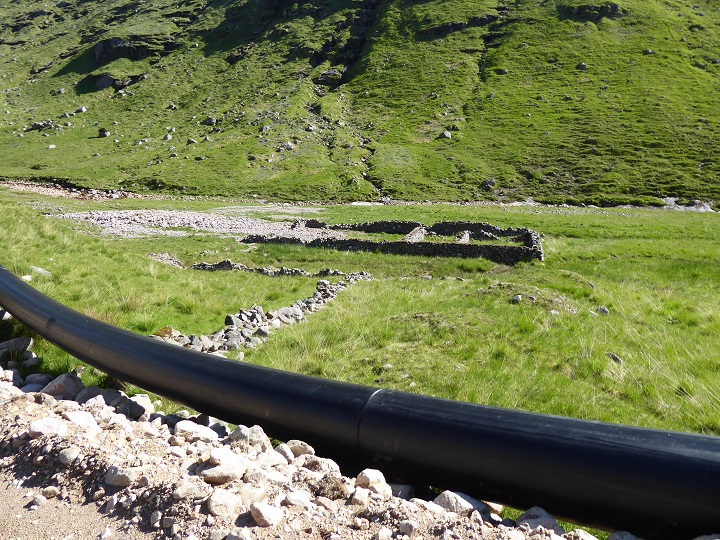
Looking at this section of pipeline, if instead of being buried it had been laid along the river, matching its line, what would the visual impact have been? Even in this open landscape, treeless because of grazing, there are places such as old river channels and behind walls where a pipe left above ground would disappear from view.
 What is likely to have most impact, trying to bury the pipe between the former sheep fanks and construction track or laying it by the river beyond?
What is likely to have most impact, trying to bury the pipe between the former sheep fanks and construction track or laying it by the river beyond?
What anyone sees, of course, will be determined to a significant extent by where the route they choose to walk. But most people follow paths so the visual impact of unburied pipes would depend on their line and generally how close they are to paths. If people continued to walk up the glen on the line of the construction track, the visual impact of an open pipe below the fanks here would be quite low.
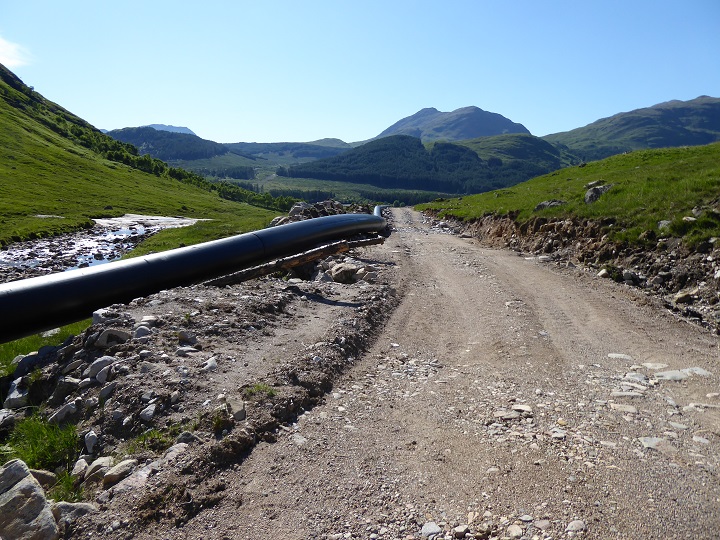 If the path was close to the river, the impact would be much higher, but would it be much worse than how these sections of track and buried pipeline will look once it is restored?
If the path was close to the river, the impact would be much higher, but would it be much worse than how these sections of track and buried pipeline will look once it is restored?
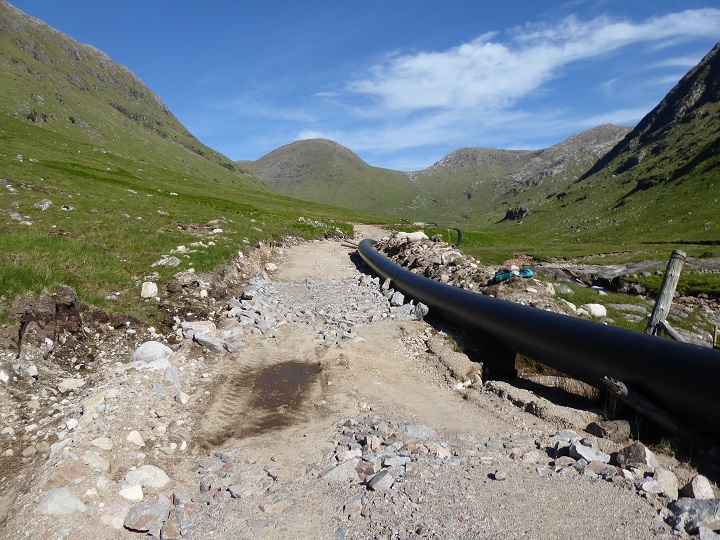
In the distance you can just see the unburied pipe snaking over the river terrace. What would the visual impact have been if the pipe had been placed on the flat ground below the terrace matching its curve?

In order to avoid boggy ground, the track and pipeline contour round the hillside and a section of the fine old wall has been demolished. Would a direct line, in the open, following the line of the fence, looked any worse?
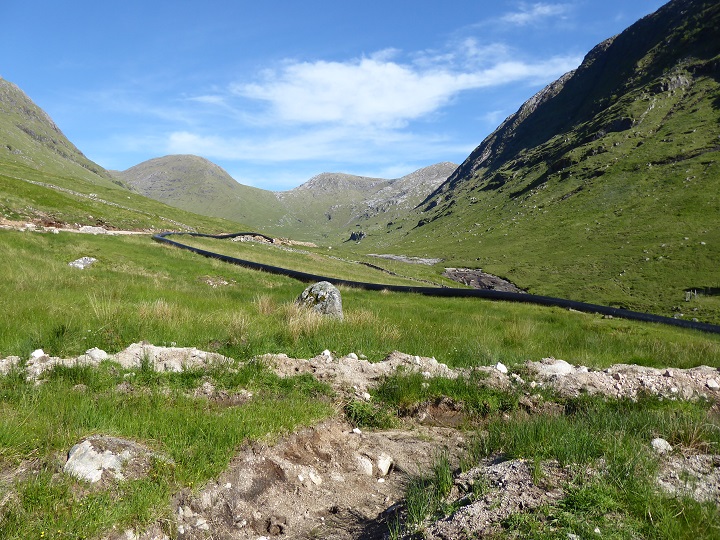
Left in the open on its current line, which cuts across the view, the pipeline would look terrible. But what if a more direct route, following the line of the river and glen, was taken?

Near the bottom of the pipeline, a few trees start to appear. If the number of grazing animals were reduced these trees would soon regenerate naturally and develop into woodland. Any pipeline which had been left in the open would soon disappear behind the trees.
Land-use determines visual impacts so, where it is decided to put in hydro schemes, why not change it? The woodland would add to any beneficial impact that run of river hydro schemes have on reducing carbon levels in the atmosphere.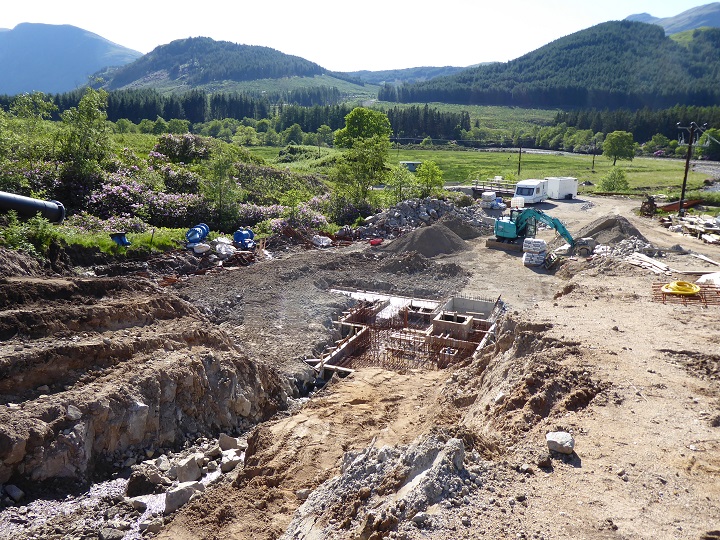
Back to the beginning, the pipeline trench through the rock viewed from aboveThe intake area looks absolutely dire at present but in the medium term the presence here of trees and invasive rhododendron means it is likely to disappear from view far more quickly than the Allt Ceitlein hydro intake.
What needs to happen?
The main drive behind hydro schemes has not been to increase the amount of renewable energy – the seven schemes in Glen Etive will produce as much as one wind turbine in the North Sea – but the desire of landowners, developers and financiers to profit to from the vast subsidies government provided in the form of Feed In Tariffs, paid for by the public. In order to maximise profits, many cut every corner they can, including what they pay construction staff who often work in appalling conditions.
While the practice of requiring developers to bury the pipes was intended as a means of reducing the landscape and ecological impacts of hydro schemes and make them acceptable to the public, in practice it has not worked. And, to add insult to injury, burying the pipes has released even more carbon into the atmosphere.
Instead of responding to this disaster and reviewing what needs to change, our responsible public authorities, led by NatureScot and followed by the Loch Lomond and Trossachs National Park Authority, have ignored it (there have been far fewer run of hydro schemes in the Cairngorms). Scotland deserves a public inquiry into what has gone wrong. But meantime, where new hydro schemes are under consideration, perhaps it is time to involve the public and ask them whether it might not be better in certain to leave the pipes above ground and to promote naturally regenerating native woodland to reduce the landscape impact?
The conflicts in public policy are laid bare.
The drive for renewable energy against the drive to protect wild places. The drive to regulate properly against the drive to cut the cost to the public.
The biggest issue is always going to be the drive to cut costs. The developers argue against unreasonable burdens, the planners dont have the staff time or knowledge to administer the process. Contractors ALWAYS try to find short cuts to save time and money. All of this happens against the backdrop of remote locations, seasonal challenges and extreme weather events. This inevitably means that if something might go wrong, it will go wrong.
We now know enough about what can go wrong to know what needs to be done to make these schemes workable. The problem is that it does not have the high profile needed to trigger the release of the additional funding.
We must wonder at this heavy machinery – break up the planet – method.
Hydro power at small scale became the way many remote “Country houses” across Scotland were able to have DC electrical systems fitted,when that first became technically possible in the early 20th century , some even earlier. I have come across ancient feed pipes high on hillsides and investigated three such installations close up.
Header dams were built in situ using locally quarried stone and wooden parapets. Cast iron gate valves (presumably delivered by horse or winch powered sled), fed into cast iron pipe sections laid across open ground. These ran down along side water courses hundreds of feet to a turbine house- again built using local materials.
Each “cup and socket” joint between these 10 – 15 ft sections of pipe rested on a small concrete plinth, dug down to found on bedrock. The concrete appears to have been hand mixed on the spot, then poured into a ‘tailored’ timber former, to achieve a maximum pipe-link angle. The pipe sections must have been lifted using A frames after being dragged into position using horses and pulleys. The pipe joints are clamped together using band clamps , and the finished lengths were usually wrapped and hot tarred. Any sections suffering fracture or frost damage could be lifted out and replaced. These pipes run for hundreds of feet down hillsides.Some installations remain serviceable at full pressure many decades later. Small scale Hydro Installations of this type fed the sites of many large estate houses across the highlands Examples of these pipe runs still lie on Morvern, above Loch Moidart, and on the Isle of Rum. Most are very hard to spot now, even across open slopes. Lichens liverwort and mosses,verdigris, leaf fall, grass die back, bracken and fallen trees have cloaked them again.
Did engineers forget ?
“Did engineers forget ?” You probably have to employ engineers in the first place, and they come at a cost landowners simply don’t want to pay.